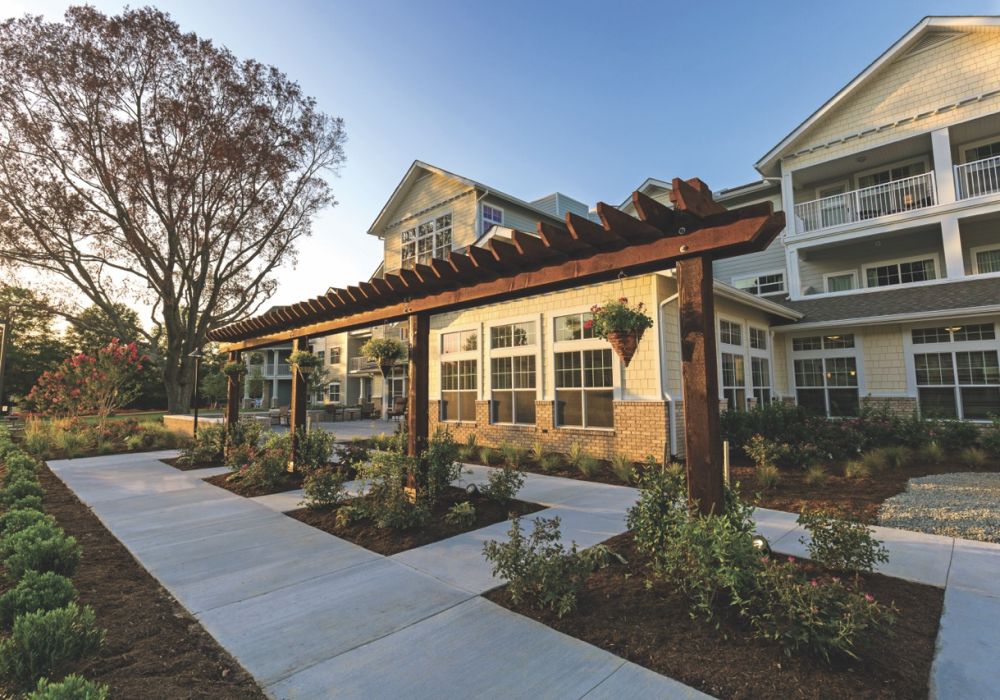What are CCRCs and How Do they Work

If you are looking for a senior living community that can provide you with a full range of care options as you age, you may want to consider a CCRC. A CCRC, or a continuing care retirement community, is a type of retirement community that offers a tiered approach for aging adults. CCRCs offer a full continuum of care options, meaning everything from independent or assisted living to memory care and skilled nursing care. Typically, residents move into single-family apartments or condominiums designed for independent, healthy adults. As their needs change over time, they can transition to other levels of care within the same community.
CCRCs are also known as life plan communities because they allow residents to plan ahead for their future care needs and preferences. CCRCs can provide peace of mind, convenience, and continuity for seniors and their families. However, CCRCs also come with different costs, contracts, and considerations that you should be aware of before making a decision.
How Do CCRCs Work with Pricing and Financing?
One of the main features of CCRCs is that they offer different pricing and financing models that can suit different budgets and situations. Generally, there are two types of fees involved in CCRCs: an entrance fee and a monthly fee.
• Entrance fee: This is a one-time fee that you pay upfront when you join a CCRC. The entrance fee can range from tens of thousands to hundreds of thousands of dollars depending on the type, size, location, and quality of the community and the unit. The entrance fee may also vary depending on whether it is refundable or nonrefundable. A refundable entrance fee means that you or your heirs can get back some or all of the fee when you leave the community or pass away. A nonrefundable entrance fee means that you or your heirs cannot get back any of the fee when you leave the community or pass away.
• Monthly fee: This is an ongoing fee that you pay every month for living in a CCRC. The monthly fee can range from a few hundred to several thousand dollars depending on the type, size, location, and quality of the community and the unit. The monthly fee may also vary depending on the level of care and services that you receive. Some CCRCs offer a fixed monthly fee that covers all levels of care and services regardless of your needs. Some CCRCs offer a variable monthly fee that changes according to your level of care and services.
There are different types of contracts or agreements that CCRCs offer based on their pricing and financing models. Generally, there are three types of contracts: Type A (life care), Type B (modified), and Type C (fee-for-service).
• Type A (life care): This is the most comprehensive and expensive type of contract. It requires a high entrance fee and a fixed monthly fee that covers all levels of care and services for life. This means that you will not have to pay extra for moving to higher levels of care such as assisted living or skilled nursing care within the community.
• Type B (modified): This is a less comprehensive and less expensive type of contract. It requires a lower entrance fee and a fixed monthly fee that covers some levels of care and services for life. This means that you will have to pay extra for moving to higher levels of care such as assisted living or skilled nursing care within the community after using up a certain amount or period of coverage.
• Type C (fee-for-service): This is the least comprehensive and least expensive type of contract. It requires a low entrance fee and a variable monthly fee that covers only the level of care and services that you use at any given time. This means that you will have to pay extra for moving to higher levels of care such as assisted living or skilled nursing care within the community whenever you need them.
There are also other types of contracts or agreements that some CCRCs offer based on their pricing and financing models. For example,
• Rental: This is a type of contract that does not require an entrance fee but only a monthly fee that covers the rent and some basic services. You can cancel or terminate the contract at any time without penalty. However, you will not have access to higher levels of care within the community unless you pay for them separately.
• Equity: This is a type of contract that requires you to buy or own a unit or apartment within the community. You can sell or transfer the unit or apartment at any time according to the market value and the community rules. However, you will also have to pay a monthly fee that covers the maintenance and some services. You may or may not have access to higher levels of care within the community depending on the contract terms.
There are different types of pricing and financing models that CCRCs offer based on their entrance fees, monthly fees, and contracts or agreements. There are also different types of financing options that can help you afford the cost of living in a CCRC. However, each option has its own advantages and disadvantages and may not be suitable or available for everyone. It is important to do thorough research and consult with a financial planner or a senior living advisor before choosing a pricing and financing option.

What Are Some Pros and Cons Between CCRCs and Traditional AL/IL/Memory Care Communities?
CCRCs are different from traditional assisted living (AL), independent living (IL), or memory care communities in many ways. CCRCs offer a full continuum of care options within one community, while traditional communities offer only one level of care within one community. CCRCs allow you to plan ahead for your future care needs and preferences, while traditional communities require you to move to another community if your needs change over time.
There are some pros and cons between CCRCs and traditional AL/IL/memory care communities that you should consider before making a decision.
Some of the pros of CCRCs are:
• Peace of mind: CCRCs can provide peace of mind for you and your family because you know that you will have access to all levels of care within one community if you ever need them. You do not have to worry about finding another community or moving to another location if your needs change over time.
• Convenience: CCRCs can provide convenience for you because you do not have to deal with multiple contracts, fees, or providers for different levels of care. You also do not have to pack up your belongings or adjust to new surroundings if you move to another level of care within the same community.
• Continuity: CCRCs can provide continuity for you because you can maintain your relationships with your friends, neighbors, staff members, and health care providers within one community. You can also enjoy consistent consistent quality and standards of care and services across all levels of care within one community.
Some of the cons of CCRCs are:
• Cost: CCRCs can be costly for you because they require a high entrance fee and a monthly fee that may be higher than the fees of traditional communities. You may also have to pay extra fees for certain services or amenities that are not included in your contract or agreement. You may also have to forfeit some or all of your entrance fee if you leave the community or pass away.
• Commitment: CCRCs can be restrictive for you because they require a long-term commitment and a binding contract or agreement that may be difficult to cancel or terminate. You may also have to abide by certain rules or regulations imposed by the community or the contract or agreement. You may also have limited options or choices for moving to another community or location if you are unhappy or dissatisfied with the community.
• Risk: CCRCs can be risky for you because they depend on the financial stability and viability of the community and the provider. If the community or the provider goes bankrupt, fails to meet its obligations, or changes its policies or practices, you may lose some or all of your entrance fee, monthly fee, or benefits. You may also have to move to another community or location if the community closes down or reduces its services.
Some of the pros of traditional AL/IL/memory care communities are:
• Affordability: Traditional communities can be affordable for you because they do not require an entrance fee and only charge a monthly fee that covers the rent and some basic services. You may also qualify for financing options or assistance programs that can help you pay for the cost of living in a traditional community.
• Flexibility: Traditional communities can be flexible for you because they do not require a long-term commitment and only have a lease or an agreement that can be canceled or terminated at any time without penalty. You may also have more freedom, choice, and control over your living arrangements and lifestyle in a traditional community.
• Diversity: Traditional communities can be diverse for you because they offer different types of housing options, locations, features, and amenities that can suit different needs and preferences. You may also have more opportunities to meet new people, explore new places, and try new things in a traditional community.

Some of the cons of traditional AL/IL/memory care communities are:
• Uncertainty: Traditional communities can be uncertain for you because you do not know if you will have access to higher levels of care within the same community or nearby if you ever need them. You may have to worry about finding another community or moving to another location if your needs change over time.
• Inconvenience: Traditional communities can be inconvenient for you because you may have to deal with multiple contracts, fees, or providers for different levels of care. You may also have to pack up your belongings or adjust to new surroundings if you move to another level of care within a different community.
• Discontinuity: Traditional communities can be discontinuous for you because you may lose your relationships with your friends, neighbors, staff members, and health care providers within one community. You may also experience inconsistent quality and standards of care and services across different levels of care within different communities.
Therefore, there are some pros and cons between CCRCs and traditional AL/IL/memory care communities that you should consider before making a decision.
Conclusion
A CCRC is a type of senior living community that offers a full range of care options within one community. A CCRC allows you to plan ahead for your future care needs and preferences. A CCRC also offers different pricing and financing models that can suit different budgets and situations. However, a CCRC also comes with different costs, contracts, and considerations that you should be aware of before making a decision.
A traditional AL/IL/memory care community is a type of senior living community that offers only one level of care within one community. A traditional community requires you to move to another community if your needs change over time. A traditional community also offers different housing options, locations, features, and amenities that can suit different needs and preferences. However, a traditional community also comes with different fees, leases, and risks that you should be aware of before making a decision.
We hope that this article has been informative and helpful for you. If you have any questions or comments, please feel free to contact us at [email protected]. We are a website that helps seniors find the best senior living facilities for their needs and preferences. We offer free consultations and personalized recommendations based on your budget, location, lifestyle, and care needs. We also provide useful resources and tips on senior living topics such as cost, financing, moving, downsizing, and more.